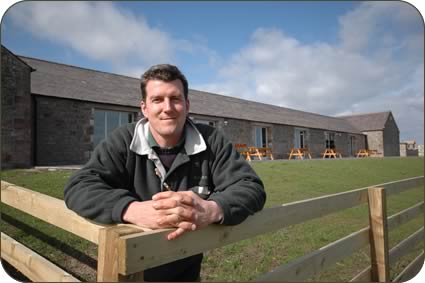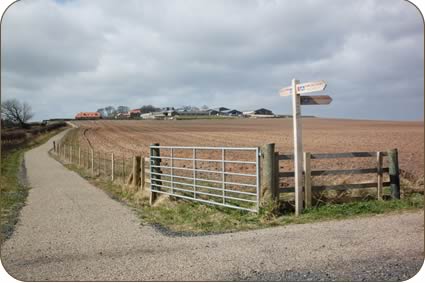Jennifer MacKenzie is an agricultural photo journalist with almost 30 year's experience. Operating from her base in Cumbria, Jennifer undertakes mainly industry-related freelance writing and photography.
Visitor centre sheds light on farming today
A Northumberland farmer’s five-year vision to open his farm to the
public and give them inside knowledge of the industry has finally come
to fruition.
Rod Smith farms just over 1,000 acres at Beal Farm, Beal, where around
500,000 visitors a year pass his door on the way to the island of Lindisfarne
across the causeway.
 |
| Rod Smith outside the barn |
He has taken the opportunity to heavily invest in converting a former
cartshed with views across to Holy Island into an eco-friendly visitor
centre and restaurant serving locally-produced food as well as creating
a network of tracks across his arable land where the public can see the
area’s
wealth of flora and wildlife which has family has been keen to nurture.
A special ‘live tide’ camera means that visitors can even watch
the wildlife from the comfort of the barn in inclement weather!
The Barn at Beal which opened in mid-February is the result of collaboration
between Rod and Natural England which will enable visitors and school children
to see the challenges facing farming today while protecting wildlife and
the environment for future generations.
“I started the project five years ago because of the way farming
was at the time. Cereals were at around £70 a tonne and I thought
if that was to continue I had to do something other than just farming for
the sake of our children,” said Rod. He and his wife Vicky have three
children, William, six, Jessica, five and Sophie, 18 months.
“Around that time I had also been to Glendale Show and it became
apparent that the children who were there knew very little about where
their food originated and I decided to look at creating a project here
to combine all this.”
The stone built cart shed which stands alone dating from the 1820s then
used for storage was an obvious choice for development.
 |
| The Barn Restaurant |
Conversion work began in November 2006 with the 30 metre long cart shed’s
openings being swapped to the opposite side of the building to take in
the spectacular sea views. A kitchen and classroom/lecture room were built
on either end.
“From an environmental point of view the building had to be sustainable.
We live in a draughty farmhouse which dates from 1674 and I know what it
costs to heat it.
“The barn has been fully insulated and the under floor heating system
and hot water are powered by a ground source heat pump which gathers ground
heat from 800 metres of pipe which we laid in the field.
“The system was a big investment which we estimated originally to
have an eight-year payback but now with the price of oil and energy escalating
it is down to five years and possibly soon will be less – and it
has proved to be very effective.”
Even the live-tide camera on the shore which relays images to the visitor
centre operates on solar power and hydro electricity with a five-day back-up.
 |
| The tracks across the farm from the barn |
From the centre visitors can walk on the four miles of designated permissive
footpaths created three years ago which cross-cross the arable land next
to the sea and form circular routes.
The farm’s proximity to Lindisfarne and the Scottish Border means
it is steeped in history and it is in the Northumberland Coast AONB.
Originally in Countryside Stewardship, the farm is now in the HLS. It has
three ponds, two of which are recently created. They are fresh water, salt
water and a mixture of both and at them bird watching hides are soon to
be built by Natural England.
The farmland is being managed specifically with wildlife in mind from wild
flowers to butterflies and beetles.
Wet grassland is maintained for wading birds with seed plots for birds
such as lapwings, corn buntings and tree sparrows and six miles of restored
hedgerows providing habitats for smaller birds such as finches and yellow
hammers.
An integral part of the farm is a goose management project. To feed the
large number of Brent gees which over-winter in the area, a field is broadcast
in the autumn with winter barley seed provided free by Mcreath Simpson
and Prentice in Berwick.
For the first time last autumn, 50 acres was put into the project and,
as part of the farm’s arable rotation, the acreage will vary to up
to 85 acres in following years. Once the geese have migrated, the field
is sown with spring barley and the project has proved a success in its
first winter.
All but 70 acres of the farm which is let out to a neighbouring farmer
for livestock is arable with 500 acres down to winter wheat selling for
feed, 200 acres of malting barley as well as 75 acres of vining peas and
35 acres of beans grown as part of a co-operative.
“The project has been a phenomenal investment. Once we were into
the work we decided to go for the best quality we could in the build and,
as a result, the grant aid has worked out at about 20 per cent of the total
cost,” said Rod.
“Even such a short time after opening we’re getting a lot of
visitors, many of whom are local, and we’re inviting constructive
criticism and suggestions about our menus and facilities in order to improve
on them.
“The project is fulfilling a number of objectives as well as allowing
me to better manage the farming operation alongside it in terms of controlling
the geese – I had stopped growing winter barley – and allowing
the people access along the new tracks whereas previously they would trespass
on all the farm land.”
The visitor centre has also benefited the local community in creating 12
new full time jobs – highlighting the changes in agriculture as now
only one man is employed on the land compared with six in 1972 when the
Smith family took over the farm at Beal.
Once the visitor centre business is established, a next phase to make use
of the farm’s remaining redundant stone farm buildings could be their
conversion to provide letting units for craft workshops and other local
small businesses.
For more information visit the website at: www.barnatbeal.com

